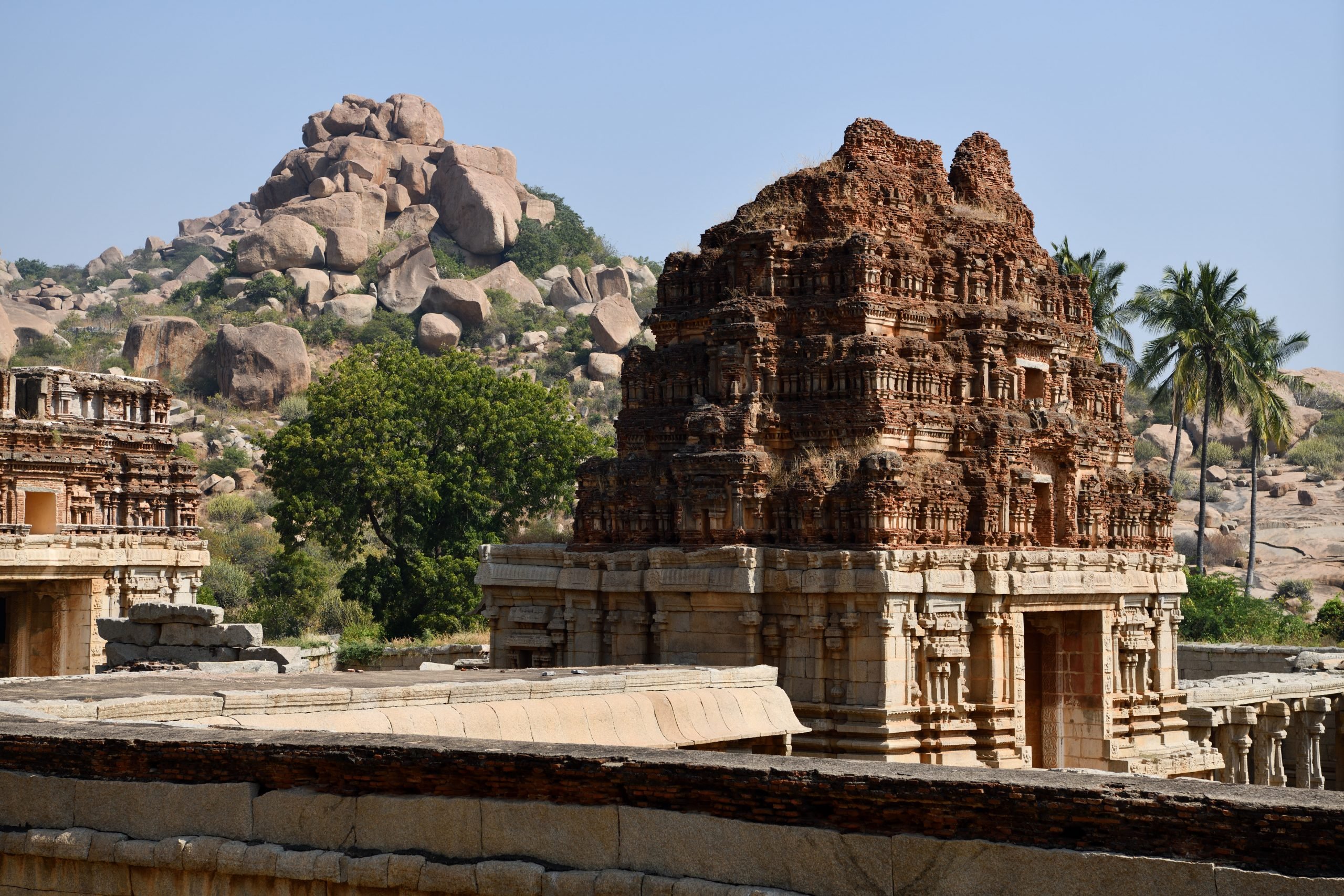
On the banks of India’s Tungabhadra river, strewn across craggy hills and lush plains dotted with massive granite boulders, lie the remains of grandiose monuments at Hampi. The Vijayanagar kingdom lasted for 300 years after its establishment in the mid 1300’s. In the 1500s, at the height of its power and influence, the city boasted a population of over 500,000.
Today a UNESCO World Heritage site, Hampi is the former capital city and crown jewel of Vijayanagar, the last great Hindu empire of Southern India. It rose to prominence as a bastion for Hinduism, protecting Southern India from invading sultanates in the north. The kingdom was both heavily militaristic, renowned for its powerful armies and strategic forts, and economically prosperous, fostering trade of textiles, spices, and gemstones with Asian and European merchants through its port cities. The Vijayanagara used their wealth to propel art and culture, developing India’s classical music, dance, literature, and architecture.
View of the upper portion of Virupaksha Temple, Hampi, Karnataka, India. Photo: Jithendra M./IndiaPictures/Universal Images Group via Getty Images.
Hampi is site to a collection of hundreds of monuments, including some of India’s most significant architectural marvels which vary in size from humble shrines to mammoth temple complexes. The Virupaksha temple is one of the largest at Hampi. Dedicated to Shiva, one of Hinduism’s principal deities, the temple has been in constant use by worshippers since the 7th century, though most of its architectural grandeur was added by the Vijayanagara. The temple’s main gopuram (entrance tower) was built in the 15th century, an imposing structure that rises to almost 165 feet. The gopuram’s two lower stories are made of granite, while the seven above are a superstructure made of brick and mortar with carved stucco figures. Crowning the tower is a shalashikhara, designed after a barrel laying on its side.
The Virupaksha temple is considered a mathematical wonder as it replicates geometric precision found in nature through the concept of fractals, complex patterns that repeat themselves. Gazing upwards at the temple’s ceiling, the carved patterns split and replicate, much like the crystals in snowflakes or the hypnotizing spiral of seashells.
The stone chariot is escorted by two elephant statues, one of the main attractions at Hampi. Photo: Phil Clarke Hill/In Pictures via Getty Images.
One of the most dramatic architectural showpieces of Hampi is the Vittala temple, which draws in visitors with its pillared halls, sprawling campus, and its iconic stone chariot. The chariot is designed as an imitation of traditional wooden temple processional chariots. It is made from intricately carved granite blocks, and rests on a rectangular platform adorned with scenes of great battles and mythology. Its wheels, cut from separate stone blocks and decorated with floral motifs, once rotated on their axles. Originally, the chariot was drawn by two stone horses, but the equestrian escorts have been replaced by elephant sculptures.
Other enchanting features of the Vittala temple include its 56 musical pillars. The SaReGaMa pillars, named after the Do-Re-Mi-Fa of Indian classical music, stand almost 12 feet tall, holding up the Ranga Mantapa, an open pavilion at the Vittala complex. The 56 pillars, made with variations in width and height, “sing” in different tones when tapped. It is speculated that the stone columns were once tapped, or sometimes blown into, to accompany devotional performances and chants at the pavilion.
The Royal Elephant stable. Photo: Jithendra M./IndiaPictures/Universal Images Group via Getty Images.
It might come as a surprise to the western world that elephants are kept much like horses, in stables sheltering them from the elements, just bigger. The Royal Elephant stables at Hampi are like no other stable on earth, featuring a regal row of eleven alternatingly domed chambers, that each housed a pair of elephants, formerly used for ceremonies and parades held in the adjacent vast courtyard.
The Lotus Mahal. Photo: Pictures From History/Universal Images Group via Getty Images.
To the west of the stables lies one of the most photographed structures at Hampi, the Lotus Mahal, another secular, royal construction of the Vijayanagar empire. The mahal is laid out symmetrically with equal projections on each of its four sides, again replicating the fractals of an open lotus bud. It is thought that the structure served as a speaking room for women, or as a space for conference and relaxation for kings.
The architectural marvels of Hampi are a testament to the grandeur and ingenuity of the Vijayanagara Empire, relics of its artistic mastery, cultural richness, and technological innovation. The magnificent ruins both celebrate the empire’s past glory and continue to inspire wonder and admiration in visitors and worshippers alike, preserving Hampi’s legacy as one of India’s most cherished historical treasures.
Sometimes, archaeology gets big. In Huge! we delve deep into the world’s largest, towering, most epic monuments. Who built them? How did they get there? Why so big?